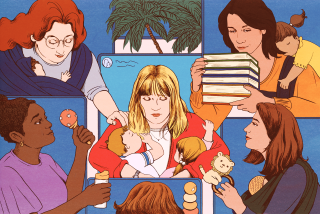Patients swamped with medical bills find a solution in crowd-funding

Vanessa Hulme at her Reseda home. She was leery of crowd-funding for herself; it was her sister who started a YouCaring campaign on her behalf. “I’m sort of the person who doesn’t like to ask for help,” she says.
When a young couple from Florida couldn’t get their insurance company to pay for in-vitro fertilization, they turned to the Internet for help.
Using a crowd-funding website called Indiegogo, they set up a campaign to raise $5,000. Online contributions of more than $8,000 ultimately rolled in from friends, family and strangers. And now they have a baby.
That’s the power of a crowd, says Slava Rubin, CEO of Indiegogo, based in San Francisco.
Crowd-funding has grown along with the Internet as people increasingly band together to support charities, raise money for movies and other projects — and now seek money to pay medical bills.
Indiegogo, which launched in 2008 to help filmmakers raise money online, has seen such a marked uptick in personal fundraising to pay for medical costs that it recently started Indiegogo Life — for personal causes, including healthcare. There are a host of other medical crowd-funding sites such as GoFundMe and YouCaring — both of which also report huge increases in medical fundraising in the last two years.
------------
FOR THE RECORD:
Healthcare Watch: In the July 3 Business section, the Healthcare Watch column about the use of crowd-funding sites to help with medical bills said Indiegogo had started Indiegogo Life just for healthcare bills. The site is for healthcare and other personal causes.
------------
Unlike more traditional methods, online campaigns allow fundraisers to reach people far beyond their immediate social network. “Here’s a way to give to an individual — it might be someone you know or someone you’ve never met. You know what their need is and that your donation will go to meeting their exact need,” says Leonard Lee, head of communications for YouCaring based in San Francisco.
“A lot of people who thought they had adequate insurance coverage find themselves in situations where insurance is not enough,” he says.
Fundraisers launched through crowd-funding websites run the gamut of health conditions. Among some big successes:
• $800,000 for experimental treatment was raised in a campaign for a 24-year-old man diagnosed with leukemia.
• Nearly $267,000 was raised for a 26-year-old diagnosed with ALS to cover the cost of medical treatment and other expenses.
• More than $34,000 was collected to relieve the financial burden for the family of a 2-year-old diagnosed with stage 4 brain cancer.
Vanessa Hulme was leery of crowd-funding for herself. It was her sister who started a YouCaring campaign on her behalf.
“I was actually apprehensive about crowd-funding initially. I’m sort of the person who doesn’t like to ask for help,” says the 36-year-old self-employed singer from Reseda. She quickly came around.
As word of her online campaign spread through social media, friends, family and people Hulme had never met began donating.
Though many see crowd-funding sites as a godsend, others see their need as evidence of problems with the U.S. healthcare system.
“Most of the people who have medical bill problems” do so — even though they have insurance, says Karen Pollitz, senior fellow with the Kaiser Family Foundation.
Experts offer tips for launching a successful campaign.
Strong appeals include details people want to know. A clear, concise campaign description that makes it easy to understand who you are and why you’re asking for money is key, says Kelsea Little, media director for GoFundMe, in San Diego.
“We recognize it’s difficult for people to ask for help and talk about a very personal situation,” Lee says. “But those able to talk about what their journey has been through their illness tend to be most effective,” Lee says.
Profiles with pictures — even better, videos — tend to have greater success.
“People want to see the person behind the story and get a sense of who the person is, what their journey has been and who they are donating to,” Lee says.
Create trust. Connecting your profile to a Facebook account helps verify you are who you say you are, and where the money is going.
“It’s important to create trust, and the best way to do that is to connect with Facebook via your profile, so that people can then see how they’re connected to you through friends. Or, so that they can see you’re a real person,” Rubin says.
Those interested in donating can avoid fraud by paying close attention to the details of a person’s story and by donating on sites that scan their campaigns for potential fraud.
Watch for fees. Many crowd-funding sites charge a percentage of each donation you receive.
GoFundMe and GiveForward for example, take 5% of each donation and an additional 3% for a payment processing fee.
Indiegogo Life and YouCaring do not take a percentage of the funds you raise, though donors pay a credit card transaction fee.
Hulme says crowd-funding has helped her make a dent in the financial burden caused by her illness. But she got far more from her fundraising campaign than just money, she says.
“If I had not been willing to take a leap of faith, then I would have never known how many people in the community were willing to help,” she says.
“When I could do nothing else but hold my head up, and my fiancé would say, ‘It looks like you got another $20 donation,’ I will tell you, it sounds silly, but that’s the kind of thing that keeps you going.”
Twitter: @lisazamosky
Zamosky is the author of “Healthcare, Insurance, and You: The Savvy Consumer’s Guide.”






